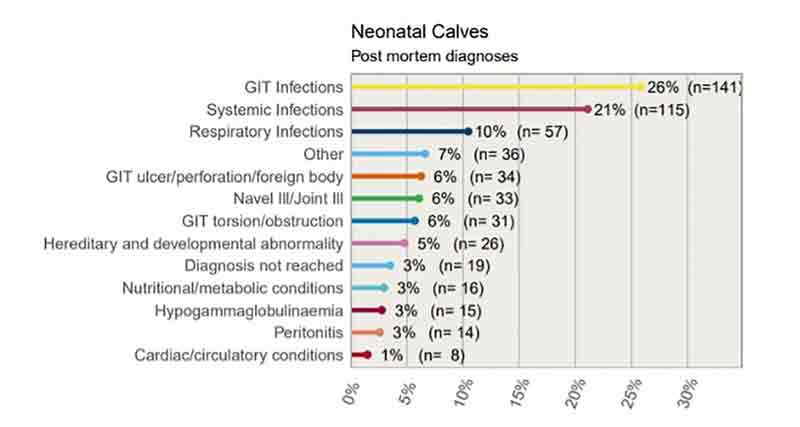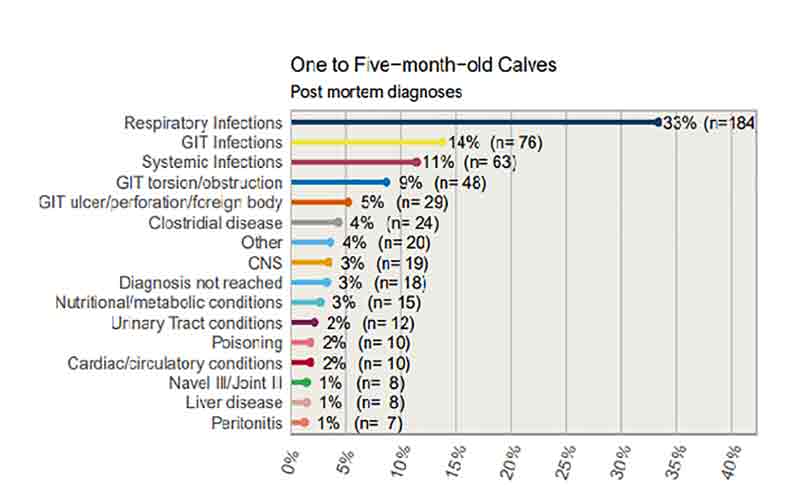9 Dec 2022
Marie-Louise Ryan discusses four fundamental factors for good calving management on farm to prevent mortalities.

Image: © Adobe Stock / etonastenka
In Ireland, dairy farms predominantly operate spring block calving systems, which means efficient production of replacement heifers is the focus from birth.
At the author’s practice, the clients are almost all spring calving, pasture-based herds. This means tremendous pressure is on the calf management systems, as the calving period is only 10 to 12 weeks long.
Very little room for error exists in calf rearing if all your heifer calves are born in a two-month period and are required to make it to calving at 22 to 24 months.
A few fundamental pillars exist in good calf management; these include:
If a breakdown occurs in any of these, it will result in breakdowns of disease including calf scour and pneumonia, as well as poor growth rates.
Figure 1, from the All Island Disease survey 20201, shows the leading cause of death in calves under 30 days is calf scour, followed by systemic infections and pneumonia.

It is important that, through management, we, as practitioners, work with our clients to try to avoid these illnesses, so improving their performance, and ultimately, sustainability.
As we know, calves are born without any immunity to infectious agents; they are entirely dependent on colostrum as a source of antibodies.
The concept of passive transfer is something farmers are becoming more aware of, but a way is still to go on that journey, so it’s important to keep pushing that discussion.
The author’s practice has made inroads in this area by breaking it down into clear messages:
We are all aware of the 3-2-1 rule, highlighting the importance of giving 3L of colostrum in the first two hours of life, from the first milking of the cow, but no harm comes in reiterating this, reminding clients and checking it is being carried out on farm.
It is important not to make assumptions about what is being practised at farm level, as this can lead to nasty surprises.
Even when it does take place, issues can arise, such as poor colostrum quality or inadequate colostrum storage, or the collection of colostrum may not be hygienic enough.
The author’s main rules for effective colostrum management are:
Vaccination of cows prior to calving can help boost the levels of antibodies to specific pathogens present in colostrum, enhancing the protection calves receive.
To reduce calf scour is significant, as is the feeding of transition milk4, to fully avail of the antibodies against the scour-causing pathogens present in the colostrum of vaccinated cows. Vaccination can help prevent scours such as rotavirus, coronavirus and Escherichia coli5.
Colostrum also contains oligosaccharides that are thought to help prevent pathogen adhesion to the intestinal epithelium, but their effects are not yet fully understood4.
As vets, we can troubleshoot/quality control by taking blood samples from calves 24 hours to seven days old and measure serum total protein. A reading of 5.5 or greater indicates good passive transfer6.
Hygiene is fundamental to disease prevention in calves. Colostrum should be harvested using clean equipment, stored in clean containers, and fed using clean feeding equipment. If you can ever observe colostrum being taken and prepared for storage, take the opportunity as it won’t be presented often. Reinforce the importance of biosecurity in calf housing.
Implementing the following controls will reduce the risk of introduction and spread of disease:
Calves have a lower critical temperature (LCT) of 15°C and calves under three weeks are the most vulnerable to change. This means during February and March – when most calves are born in Ireland – the environmental temperature is typically well below the LCT.
Under these conditions, calves need to use more energy to keep themselves warm, and this can lead to reduced growth rates and immunosuppression. Therefore, it is up to us to ensure calves are kept warm enough and provided with increased nutrition to ensure energy requirements are met.
Calves should be fed an extra 50g of milk replacer or 330ml of milk for every 50°C drop in temperature. Moisture and draughts increase the LCT8.
Below is a quick reference checklist:
Poor housing can lead to respiratory infections in calves; pneumonia is the leading cause of death in calves from one month to five months old9.
It is important calves are vaccinated against pneumonia viruses once they reach the appropriate age. A single case of pneumonia can cost as much as €136 (£117.37) per calf up front. This is in addition to the consequential loss of dairy heifers not making it to first lactation. As many as 14% of dairy heifer calves do not make it to first lactation, and pneumonia is an important cause of these losses10 (Figure 2).

The fourth and final component of calf management is feeding, and our knowledge and understanding around this is constantly evolving.
A number of different approaches to milk feeding exist. Understanding the pros and cons of each will allow you to support your clients, and recognise and resolve problems when they occur.
Some basics are: